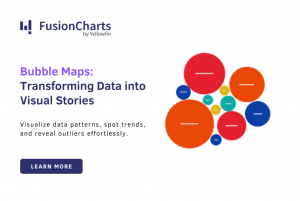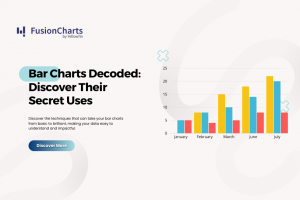This is the first post in our series ‘Principles of Data Visualization’ #PoDV
How often have you bolted on a dashboard to an almost finished product, and promptly shipped it? How often have you built a business dashboard using the most convenient chart type you could get your hands on in five minutes? How often have you had to adjust with your ineffective weekly report because you don’t know what it needs to look like? Or perhaps you have a vague idea, but can’t vocalize it to the Developer, or UX Designer so they can fix it for you? Have you ever wondered what separates a great dashboard from the mediocre ones? If that’s you, you’re not alone. Businesses today run on data. Everyone uses data visualization in their daily jobs. However, only a handful know why data visualization works, and how to use it to their benefit. Everyone does it, but no one talks about it.
In this series of posts, we go on a tour of the major ideas from the experts in data visualization. These ideas will give you a foundational understanding of how we process visual information. You can use them to create better product dashboards, give better feedback to your Product Managers and UX Designers, and become more efficient in how you analyze data. We start the series with this post explaining why we use visualizations, and what makes for a great data visualization.
Now, try the same thing with the line chart below, and you’ll notice how easy it is, taking just a second or two.

 The same information could have been found by analyzing the text records, but a visualization makes the analysis a lot more efficient.
With the advent of big data, we don’t have a shortage of data. In fact, we face the problem of information overload on a daily basis. With terabytes and petabytes of information being generated in our systems on a daily basis, we’re drowning in data. What we need is to create excellent data visuals that communicate valuable ideas from the sea of data that surrounds us. The need for visualization is more now than ever before.
In the upcoming posts, we’ll look at even more principles that’ll help us create excellent data visualizations. Let’s move from a fear of getting our hands dirty with data visualization, to confidently being able to spot a bad visual from a good one. Let’s not just do, but talk data visualization. Next week, we’ll look at the two goals behind all visuals, and learn when to use each of them.
If you’d like to get an overview of this entire series in one read, get our white paper ‘Principles of Data Visualization.’ Of course, we’ll be covering the topics in more detail here on our blog, so keep track of these posts too.
The same information could have been found by analyzing the text records, but a visualization makes the analysis a lot more efficient.
With the advent of big data, we don’t have a shortage of data. In fact, we face the problem of information overload on a daily basis. With terabytes and petabytes of information being generated in our systems on a daily basis, we’re drowning in data. What we need is to create excellent data visuals that communicate valuable ideas from the sea of data that surrounds us. The need for visualization is more now than ever before.
In the upcoming posts, we’ll look at even more principles that’ll help us create excellent data visualizations. Let’s move from a fear of getting our hands dirty with data visualization, to confidently being able to spot a bad visual from a good one. Let’s not just do, but talk data visualization. Next week, we’ll look at the two goals behind all visuals, and learn when to use each of them.
If you’d like to get an overview of this entire series in one read, get our white paper ‘Principles of Data Visualization.’ Of course, we’ll be covering the topics in more detail here on our blog, so keep track of these posts too.
Why We Visualize Data
We visualize information to meet a very basic need – to tell a story. It’s one of the most primitive forms of communication known to man, having its origins in cave drawings dated as early as 30,000 B.C., even before written communication, which emerged in 3,000 B.C. With the passing of time, we’ve found new ways to tell stories. Today, we tell stories using data. We’re familiar with the basic chart types like the line chart, bar chart, and pie chart. However, the underlying reason we use these charts is the same – to tell a story about the data it represents.The Importance of Visualizations in Business
A visual can communicate more information than a table in a much smaller space. This trait of visuals makes them more effective than tables for presenting data. For example, notice the table below, and try to spot the month with the highest sales.|
Month |
Jan |
Feb |
Mar |
Apr |
May |
Jun |
|
Sales |
45 |
56 |
36 |
58 |
75 |
62 |

This trait of visualizations is what makes them vital to businesses. Consequently, companies that tend to be most data-centric, also have a strong focus on visualization. Data visualization has become one of the key differentiators in today’s competitive landscape.
What Makes a Great Data Visualization?
Edward Tufte, a data visualization expert, says that an excellent data visual ‘is that which gives to the viewer the greatest number of ideas in the shortest time with the least ink in the smallest space.’ This quote is from his influential book ‘The Visual Display of Quantitative Information’, where he goes on to give an example of how John Snow used a visual to stop a Cholera breakout in London in 1854. The deaths in the area are plotted as dots, and the pumps that gave water to the residents are plotted as crosses. The pump on Broad Street was identified as infected, and was removed, putting an end to the deaths. The same information could have been found by analyzing the text records, but a visualization makes the analysis a lot more efficient.
With the advent of big data, we don’t have a shortage of data. In fact, we face the problem of information overload on a daily basis. With terabytes and petabytes of information being generated in our systems on a daily basis, we’re drowning in data. What we need is to create excellent data visuals that communicate valuable ideas from the sea of data that surrounds us. The need for visualization is more now than ever before.
In the upcoming posts, we’ll look at even more principles that’ll help us create excellent data visualizations. Let’s move from a fear of getting our hands dirty with data visualization, to confidently being able to spot a bad visual from a good one. Let’s not just do, but talk data visualization. Next week, we’ll look at the two goals behind all visuals, and learn when to use each of them.
If you’d like to get an overview of this entire series in one read, get our white paper ‘Principles of Data Visualization.’ Of course, we’ll be covering the topics in more detail here on our blog, so keep track of these posts too.
The same information could have been found by analyzing the text records, but a visualization makes the analysis a lot more efficient.
With the advent of big data, we don’t have a shortage of data. In fact, we face the problem of information overload on a daily basis. With terabytes and petabytes of information being generated in our systems on a daily basis, we’re drowning in data. What we need is to create excellent data visuals that communicate valuable ideas from the sea of data that surrounds us. The need for visualization is more now than ever before.
In the upcoming posts, we’ll look at even more principles that’ll help us create excellent data visualizations. Let’s move from a fear of getting our hands dirty with data visualization, to confidently being able to spot a bad visual from a good one. Let’s not just do, but talk data visualization. Next week, we’ll look at the two goals behind all visuals, and learn when to use each of them.
If you’d like to get an overview of this entire series in one read, get our white paper ‘Principles of Data Visualization.’ Of course, we’ll be covering the topics in more detail here on our blog, so keep track of these posts too.


